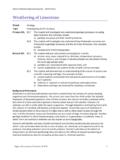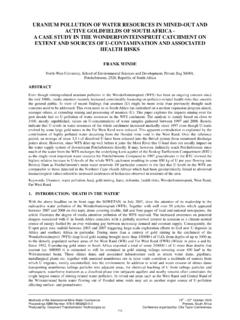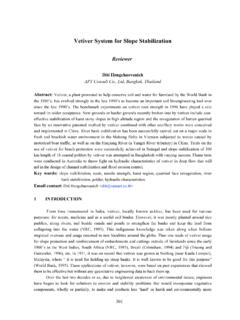Transcription of Mycodiversity studies in selected ecosystems of Greece: IV ...
1 Posted June, 2008. Summary published in Mycotaxon 104: 39 42. 2008. Mycodiversity studies in selected ecosystems of Greece: IV. macrofungi from Abies cephalonica forests and other intermixed tree species (Oxya Mt., central Greece). D IMOU1*, ZERVAKIS2 & E. POLEMIS1. * 1. Agricultural University of Athens, Lab. of General & Agricultural Microbiology, Iera Odos 75, GR-11855 Athens, Greece 2. National Agricultural Research Foundation, Institute of Environmental Biotechnology, Lakonikis 87, GR-24100 Kalamata, Greece Abstract In the course of a nine-year inventory in Mt. Oxya (central Greece) fir forests, a total of 358 taxa of macromycetes, belonging in 149. genera, have been recorded. Ninety eight taxa constitute new records, and five of them are first reports for the respective genera (Athelopsis, Crustoderma, Lentaria, Protodontia, Urnula).
2 One hundred and one records for habitat/host/substrate are new for Greece, while some of these associations are reported for the first time in literature. Key words biodiversity, macromycetes, fir, Mediterranean region, mushrooms Introduction The mycobiota of Greece was until recently poorly investigated since very few mycologists were active in the fields of fungal biodiversity, taxonomy and systematic. Until the end of '90s, less than species of macromycetes occurring in Greece had been reported by Greek and foreign researchers. Practically no collaboration existed between the scientific community and the rather few amateurs, who were active in this domain, and thus useful information that could be accumulated remained unexploited. Until then, published data were fragmentary in spatial, temporal and ecological terms. The authors introduced a different concept in their methodology, which was based on a long-term investigation of selected ecosystems and monitoring-inventorying of macrofungi throughout the year and for a period of usually 5-8 years.
3 The first integrated results have been already published in previous papers (Dimou et al. 2000, 2002, Zervakis et al. 2002a, 2002b). The data presented in this paper were accumulated during the period 1996-2004. Oxya Mt. lies in the middle of the continental region of Sterea Hellas and forms the natural limit between the administrative prefectures of Fthiotida, Evrytania and Aitoloakarnania. More details about this mountain (map, forests distribution, edaphic and climatic conditions) have been Dimou, Zervakis & Polemis 2. presented in the first part of this study concerning the mycobiota of the beech forest (Dimou et al. 2002). The data presented in this work derive from research on the biodiversity of macromycetes occurring in the fir forests growing on the eastern slope of the Oxya Mt. The vegetation there presents a characteristic zonation of different forest types: the alpine zone is succeeded either by the beech forest (in the central region of this part of the mountain) or directly by Abies cephalonica Mill.
4 Forests (in the northern and southern regions), which in turn are succeeded by deciduous oak forests (Quercus pubescens Willd., Q. frainetto Ten. and Q. petraea (Matt.) Liebl. ssp. petraea) located in lower altitudes. The Abies zone lies between altitudes of 840 to 1300 m Isolated stands of fir trees (not investigated) occur also within the beech forest ( 1400 to 1600 m ). Within the northern and southern regions of the eastern slope of the Oxya Mt., A. cephalonica is intermixed mainly with Castanea sativa, Quercus spp., while compact Pinus nigra stands were established by reforestation in two positions of this zone. Other tree species, scattered within the fir forest , are Acer pseudoplatanus L., Platanus orientalis L., Prunus cocomilia Ten., Carpinus orientalis Mill., Populus spp., Cornus sp., Salix spp., Juniperus spp. (forming distinct plant communities in some positions), Ostrya carpinifolia Scop.
5 , Alnus glutinosa (L.) Gaertner and Robinia pseudoacacia L. This work is a complete list including all macromycete species recorded by the authors in the A. cephalonica forest of the Oxya Mt. and in the adjacent alpine zone. Only a few taxa have been included in the two published checklists of the Greek macrofungi (Zervakis et al. 1998, 1999). Methodology The recording process was carried out in various localities of the Abies zone in Oxya Mt., but three areas were systematically investigated: Area 1 (A1); in the vicinity of the Gardiki village: site 1 (S1): altitude 840-950 m , dominant vegetation consisting of Abies cephalonica intermixed in some localities with Castanea sativa, Alnus glutinosa, Platanus orientalis, Robinia pseudoacacia and Pinus nigra; site 2. (S2): 1,000-1,150 m , mainly A. cephalonica intermixed sporadically with Castanea sativa; site 3 (S3): 1250-1380 m , A.
6 Cephalonica and Juniperus occidentalis intermixed or present in small communities next to the alpine zone; site 4 (S4): 1,450-1,700 m , consisting of the adjacent alpine zone; site 5 (S5): 850-950 m , occupied by reforestated P. nigra, intermixed mainly with naturally grown R. pseudoacacia, but also by A. cephalonica, J. oxycedrus, Quercus spp. and C. sativa. Area 2 (A2): on the limit between Fagus-Abies forests, 1300-1350. m , along the road connecting the villages of Gardiki and Grammeni Oxya (38o47 45 N 21 58 18 E). Abies cephalonica macrofungi (Greece). Area 3 (A3): near the Grammeni Oxya village, 1100-1300 m (A. cephalonica pure and intermixed with Quercus spp., Pinus nigra and C. sativa). Field parameters, macroscopic characteristics and some macro- chemical reactions of the collected specimens were recorded in situ. Microscopic observations and micro-chemical reactions were carried out in the Laboratory of General & Agricultural Microbiology at the Agricultural University of Athens (LGAM-AUA).
7 When needed, additional examinations were performed at the Institute of Environmental Biotechnology in Kalamata (National Agricultural Research Foundation). Ascomycetes and Basidiomycetes are presented in separated sections, and within each group, the species are listed in alphabetical order. Nomenclature follows the guidelines of the latest edition of the Dictionary of Fungi (Kirk et al. 2001). Under each fungus name, information on the exact collection site, the host/substrate and the date of the record is given. In addition, data on macroscopic and microscopic features, together with pertinent comments, are presented for those records, which are new for Greece. Taxa reported for the first time in Greece are marked by an asterisk (*), while records new for Greece as concerns habitat or host/substrate are marked by a cross ( ). All the species cited in this study are deposited in the herbarium of LGAM-AUA.
8 A photographic archive is also maintained, and pure cultures are available for certain fungi. The Greek geographical names are those used in modern Greek ( dimotiki ) that are transliterated following the international standard ISO. 843 (1999). For specimens identification and classification the following references were mainly used: Bas et al. (1988-95), Bigelow (1982, 1985), Bon (1991), Breitenbach & Kr nzlin (1984-2000), Brandrud et al. (1989-98), Eriksson and Ryvarden (1973-76), Eriksson et al. (1978-88, Hansen &. Knudsen (1997-2000), Hjortstam et al. (1987, 1988), Jacquetant (1984), J lich (1984), K ljalg (1996), Kuyper (1986), Martin (1996), Montecchi &. Sarasini (2000), Moser (1983), Nauta (1987), Noordeloos et al. (2001), Ryvarden & Gilbertson (1993), Sarnari (1998). Data recorded Ascomycetes Ciboria rufofusca (O. Weberb.) Sacc.)
9 Recorded in early May 2003, on Abies cephalonica cone scales (A1S2). Only one previous record on Abies borisii-regis cone scales (Perlerou &. Diamandis 2000); probably not so rare but often overlooked. Dimou, Zervakis & Polemis 4. Gyromitra gigas (Krombh.) Cooke Recorded in April 1999 and 2000, and in May 2003 under Abies (A1S2). Only one report in the past from the Fagus forest of this mountain (Dimou et al. 2002), but it has also been found in other regions of Greece (G. Constantinidis, personal communication). Helvella acetabulum (L.) Qu l. Collected once in May 2001 under Abies. Recorded previously in Pinus nigra (Diamandis 1985), Castanea sativa (Diamandis 1992) and Quercus spp. (Constantinidis 1994, Zervakis et al. 2002b). *Lachnellula gallica (P. Karst. & Har.) Dennis On dead branches and twigs of Abies in April 2000 and 2002 (A1S2).
10 Apothecia short stipitate mm in diameter, outside white hairy, hymenium orange; spores ellipsoid 7-10 x m, asci 60-80 m long (Hansen & Knudsen 2000 report 70-105 x m) The similar looking L. subtilissima (Cooke) Dennis has slender spores 6-9 x m and asci 45- 60 long (op. cit.). Lanzia echinophila (Bull.) Korf Recorded on the inner surface of empty Castanea sativa cups in October 2000 (A1S1). Only one previous report (Minter 1988) as Rutstroemia echinophila (Bull.) H hn. on C. sativa and Quercus ithaburensis var. macrolepis cups (Minter 1988). *Morchella costata (Vent.) Pers. f. acuminata Jacquetant This species is characterized by the pale ochre- to pinkish-brown, lance- shaped pileus, the parallel longitudinal ribs (thin and blackening in the maturity), primary alveoli few, secondary alveoli rectilinear, rectangular and bottom-flattened.





